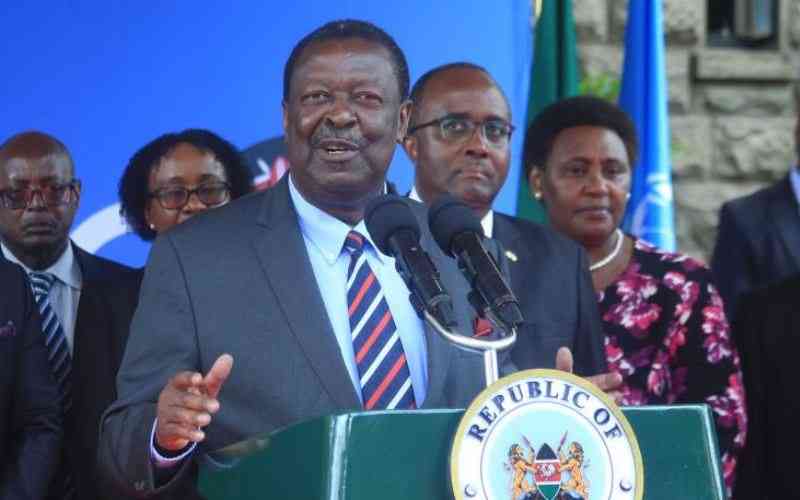Last week’s World Refugee Day was an opportunity to remind ourselves that 85 per cent of the world’s 68 million people fleeing violence and indignity are in Kenya and other developing countries.
31 people were displaced every day of last year. By December, there were three million new refugees. For them, every day is refugee day.
I spent this week in Dadaab, Garissa County listening to their experiences and what more can be done.
Kenya hosts upwards of 468,900 refugees from more than 20 countries. The majority live, school, work and do business in Dadaab, Kakuma, Nairobi, Eldoret and other towns.
Dadaab camp is still the largest with about 208,000 refugees, majority of whom are Somalis. Rising violence, punishing droughts and the absence of any basic services since the collapse of the Siad Barre regime in 1992 has led to streams of households coming over the border.
Twenty-six years on, Dadaab is now a medium size town with at least two generations of people who know no other home.
These communities have been crowded out by the heart wrenching international media stories of migrants crossing borders to seek asylum in North America and Europe.
UN agencies have decried the 30 per cent drop in humanitarian funding for Dadaab. Caught between funding dips and rising violent extremist attacks, the Kenyan Government attempted to close the camp in 2016.
They were only stopped by a court after the Kenya National Human Rights Commission and Kituo cha Sheria cited Kenya’s obligations under international human rights law and our constitution.
Forcing refugees to return to their countries and possible death is against our global obligations.
Government policy has since evolved but more is still needed. While there is no current threat of an abrupt closure and the forceful repatriation, the Government has frozen registration of new arrivals in Dadaab.
The status of over 9,000 new arrivals is currently undetermined. Without registration, they cannot access shelter, food rations, and health-care or school facilities.
Last year, over 3,000 children from over 30 primary schools in Dadaab sat national primary examinations. This year, thousands may not sit the exams for lack of documentation.
Perhaps Garissa County Government and the Interior Ministry could borrow a good idea from Turkana County Governor Josphat Nanok.
Facing similar challenges, Nanok recently announced that refugees in Kakuma should move freely within the county.
Stay informed. Subscribe to our newsletter
Free movement opens up educational, health and livelihoods opportunities. Curiosity to pursue Kenyan history is another. I was touched by primary school student Ali who told me his only wish was to visit and learn more about Fort Jesus.
The number of refugees returning to Somalia have dwindled. Violence and lack of economic opportunities and social services have made the country unattractable for those making rational choices.
Many of the 9,000 new arrivals in Dadaab include those previously repatriated back to Somalia. It is therefore unrealistic to think the need for protection in our Daadab camp is over.
The Interior Ministry must consider reopening registration in Dadaab. Modern refugee management thinking favours a local integration approach to an encampment approach.
It is less costly, boosts local economies and reduce tensions with the host community. Kakuma and Turkana County offer us a way forward.
Parliament must also urgently restart the process of developing a new refugee management law that provide for solutions like integration.
Despite building a new court house and an agreement by the Judiciary to post magistrates in Dadaab, the court seems to have stalled.
Currently, cases are heard over 100km away in Garissa. Justice is often left to the arbitration of cultural maslaha hearings led by elders and religious leaders. While rooted in the culture and religious beliefs of the Somalis, I listened to complaints that these hearings excluded women arbitrators and were unable to deter sexual assault and rape.
- The writer is Amnesty International Executive Director. Twitter: @irunguhoughton
 The Standard Group Plc is a
multi-media organization with investments in media platforms spanning newspaper
print operations, television, radio broadcasting, digital and online services. The
Standard Group is recognized as a leading multi-media house in Kenya with a key
influence in matters of national and international interest.
The Standard Group Plc is a
multi-media organization with investments in media platforms spanning newspaper
print operations, television, radio broadcasting, digital and online services. The
Standard Group is recognized as a leading multi-media house in Kenya with a key
influence in matters of national and international interest.
 The Standard Group Plc is a
multi-media organization with investments in media platforms spanning newspaper
print operations, television, radio broadcasting, digital and online services. The
Standard Group is recognized as a leading multi-media house in Kenya with a key
influence in matters of national and international interest.
The Standard Group Plc is a
multi-media organization with investments in media platforms spanning newspaper
print operations, television, radio broadcasting, digital and online services. The
Standard Group is recognized as a leading multi-media house in Kenya with a key
influence in matters of national and international interest.









